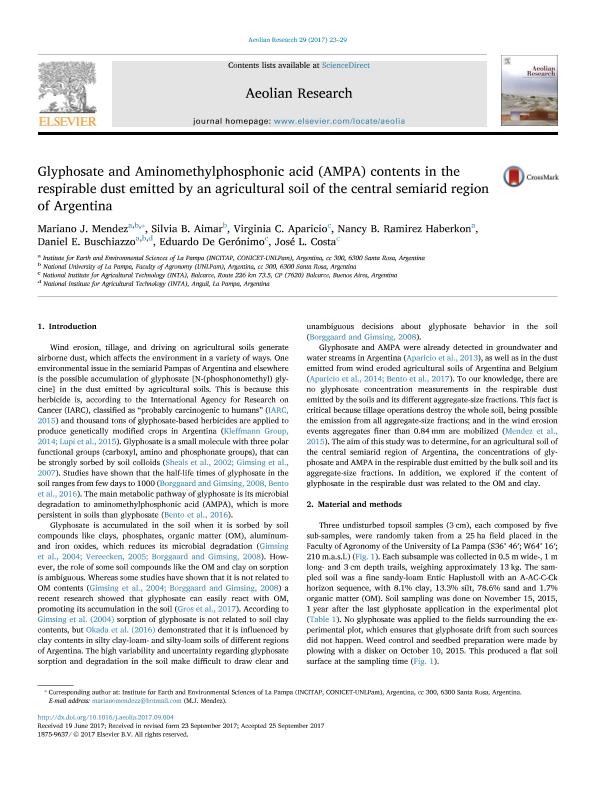Artículo
Glyphosate and Aminomethylphosphonic acid (AMPA) contents in the respirable dust emitted by an agricultural soil of the central semiarid region of Argentina
Mendez, Mariano Javier ; Aimar, Silvia Beatriz; Aparicio, Virginia Carolina
; Aimar, Silvia Beatriz; Aparicio, Virginia Carolina ; Ramirez Haberkon, Nancy Belén
; Ramirez Haberkon, Nancy Belén ; Buschiazzo, Daniel Eduardo
; Buschiazzo, Daniel Eduardo ; de Gerónimo, Eduardo
; de Gerónimo, Eduardo ; Costa, Jose Luis
; Costa, Jose Luis
 ; Aimar, Silvia Beatriz; Aparicio, Virginia Carolina
; Aimar, Silvia Beatriz; Aparicio, Virginia Carolina ; Ramirez Haberkon, Nancy Belén
; Ramirez Haberkon, Nancy Belén ; Buschiazzo, Daniel Eduardo
; Buschiazzo, Daniel Eduardo ; de Gerónimo, Eduardo
; de Gerónimo, Eduardo ; Costa, Jose Luis
; Costa, Jose Luis
Fecha de publicación:
12/2017
Editorial:
Elsevier Science
Revista:
Aeolian Research
ISSN:
1875-9637
Idioma:
Inglés
Tipo de recurso:
Artículo publicado
Clasificación temática:
Resumen
One environmental issue in the semiarid Pampas of Argentina and elsewhere is the possible accumulation of glyphosate [N-(phosphonomethyl) glycine] and aminomethylphosphonic acid (AMPA, the main metabolite of the microbial degradation of glyphosate) in the dust emitted by agricultural soils. However, there are not glyphosate and AMPA concentration measurements in the respirable dust emitted by the bulk soils and its different aggregate-size fractions. The aim of this study was to determine, for an agricultural soil of the central semiarid region of Argentina, the concentrations of glyphosate and AMPA in the respirable dust emitted by the bulk soil and its aggregate-size fractions. The study was carried in Santa Rosa La Pampa (S36° 46´; W64° 16´; 210 m a.s.l.) in a plot where glyphosate was not used in the last 12 months. Soil samples were air dried and sieved by 2 mm (bulk soil) and with a rotary sieve to separate the following aggregate-size fractions: <0.42 mm, 0.42 to 0.84 mm, 0.84 to 2 mm, 2 to 6.4 mm, 6.4 to 19.2 mm, and > 19.2 mm. The Easy Dust Generator (EDG) was used to generate dust from different sources (the bulk soil and its aggregate-size fractions. The respirable dust was collected using an electrostatic precipitator (C&L model number GH-939) coupled to EDG. Organic matter (OM), particle size composition, glyphosate and AMPA were determined in the Sources and the respirable dust emitted by them. Results showed that OM and clay contents were different among Sources but similar in the respirable dust emitted by the different Sources. Glyphosate content varied between 1 and 3 ppb in the Sources and between 11.0 and 19.5 ppb in the respirable dust. AMPA content ranged from 80 and 150 ppb in the Sources and from 520 to 750 ppb in respirable dust. AMPA contents were higher than those of glyphosate in both, the Sources and respirable dust because the longer AMPA persistence in the soil. Enrichment ratios (ERs, quotient between concentration in respirable dust and Sources) for OM, clay, glyphosate and AMPA were higher than 1, showing that respirable dust was enriched in all these compounds. ERs for glyphosate and AMPA varied between 4 and 17 and they were higher than ERs for clay and OM which varied between 1 and 3. This indicates that glyphosate and AMPA are accumulated in the respirable dust more than clay and OM. Our results suggest that respirable dust emitted by agricultural soils can be contaminated with that herbicide and its main metabolite even 12 months after the last glyphosate application. Further studies are needed in order to assess glyphosate and AMPA in different soil classes under different land uses. Their effect on health and in the environment should also be evaluated.
Palabras clave:
Glyphosate
,
Respirable Dust
,
Wind Erosion
Archivos asociados
Licencia
Identificadores
Colecciones
Articulos(CCT - MAR DEL PLATA)
Articulos de CTRO.CIENTIFICO TECNOL.CONICET - MAR DEL PLATA
Articulos de CTRO.CIENTIFICO TECNOL.CONICET - MAR DEL PLATA
Citación
Mendez, Mariano Javier; Aimar, Silvia Beatriz; Aparicio, Virginia Carolina; Ramirez Haberkon, Nancy Belén; Buschiazzo, Daniel Eduardo; et al.; Glyphosate and Aminomethylphosphonic acid (AMPA) contents in the respirable dust emitted by an agricultural soil of the central semiarid region of Argentina; Elsevier Science; Aeolian Research; 29; 12-2017; 23-29
Compartir
Altmétricas



